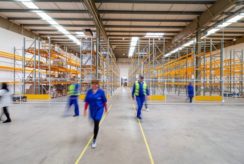At the time of writing this article, we are probably only in the middle of the COVID-19 crisis and it may seem unwise or pretentious to attempt to provide trends on what will happen to the supply chain in the coming months. Especially since the longer the crisis lasts, the more complex the recovery appears to be to plan and the more uncertain the shape of the recovery becomes.
Let’s risk it anyway with a little perspective and a lot of humility.
To do this, we will distinguish between two timeframes, the short term (the next few weeks) and the medium and long term (2021 and the next few years).
Short term impact and crisis management
In the short term, most of market sectors are being hit with varying intensity and a decline in activity of -20 to -90% depending on the sector, with the notable exception of the agri-food and pharmaceutical industries. Overall, GDP in France will fall by around 6% in the first quarter and a decline of 15 to 25% can be expected in the second quarter.
The Covid-19 crisis has had variable impacts on the supply chain, with changes over the past few weeks:
Impact on supply (production or supplies at a standstill or disrupted, transportation shortages)
Impact on demand, either a decrease in most of sectors, or an increase in certain highly targeted sectors, such as food and several areas of e-commerce
And very often there are simultaneous impacts on supply and demand.
Supply Chain specialists have been mobilized well to deal with changing situations within their companies. They are on the front line because the COVID-19 crisis is primarily a physical shock (closure of factories, warehouses, stores, reduced availability of freight carriers, employee absence and “right of withdrawal”, etc). Even if this physical shock has major financial impacts on the solvency of companies, it is not a financial shock like the 2008 crisis was.
The key actions implemented in the first few weeks of lockdown were common sense measures focusing on health safety, the full assessment of the situation and the implementation of solutions to limit ‘damage’ or respond to an increase in demand:
| Key actions | |
|
Set up SC operational crisis units with all the industrial, supply chain, logistics and transport functions |
|
|
Establish a clear vision of the situation in terms of its production and distribution capabilities and its stock availability throughout its network |
|
|
Monitor weekly the progression of customer demand as accurately as possible |
|
|
Implement good health safety practices in logistics operations (working in 2 teams, social distancing rules) and with its transport partners |
|
| Products/sectors in high demand | Products with low demand |
|
Securing supplies, particularly essential supplies (conducting daily meetings with key suppliers, securing payment deadlines) |
Review purchase arrangements with Suppliers
|
|
Reducing the complexity of the product offer to focus on a limited range and be more efficient with fewer resources |
|
|
Agreeing to ease customer service levels (longer turnaround periods, larger slots, etc.) |
Make a clear ramp-up plan of the (demand) activity and plan purchases and supplies accordingly
|
|
Re-allocating internal resources (teams, physical resources) between product categories, between sales channels (retail to online) and between geographical locations |
|
Medium and long term impact
In the medium term (2021 and beyond) and in the long term, in terms of SC, there will be the consolidation of 3 fundamental trends already present before the Covid-19 crisis and, above all, a huge strategic dilemma to be resolved which will undoubtedly shape the next 20 years.
While there has been a very sharp increase in globalization and thus in intercontinental flows over the last 30 years, the numbers indicate a slight slowdown and an increase in intracontinental flows over the last 5 years or so. For several years now, we have been going through a transition phase, from globalization to multi-regionalization. Therefore, the underlying trend to have more localized, shorter Supply Chains at the level of Regions / Continents was already underway.
It is clear that the COVID-19 crisis will accelerate this process, with priority given to health needs that will be the subject of strategic decisions by governments. Food products will no doubt also be affected, driven more by consumers who are more inclined to favor local French, or at least European, production.
But let’s make no mistake, there will certainly be no massive and rapid relocation of industrial activities in France or Europe. Reconstructing industrial sectors generally takes a long time. It is necessary to acquire not only the assembly or manufacturing units for finished products, but above all the entire ecosystem of subcontractors, suppliers of raw materials, components and services that are essential to the sector’s overall competitiveness. And then the post-crisis context will make companies in low-cost countries more competitive than ever and ready to do anything to conquer new market shares. Especially since some in China and elsewhere will have emerged from the crisis faster than in Europe.
In difficult times with huge variations in both supply and demand, companies that have invested the most in both Supply Chain Efficiency and Agility are the ones that do best (Note: We define Supply Chain Velocity as the combination of Agility and Efficiency).
Improving the velocity will be achieved in 3 ways:
- An in-depth knowledge of supplier networks (not just Tier 1, but also Tier 2 and Tier 3). Very few companies have invested in this subject. The Fukushima disaster was a wake-up for some and the Covid-19 crisis will surely serve as an impetus for many groups.
- Transparency at all times and in almost real time for all available supply chain resources (flow traceability, stock levels, production and distribution capabilities, etc.).
- The ability to be able to assess the impacts, simulate new scenarios and plan – replan – very quickly for new situations of change in supply or demand.
The implementation of Supply Chain Command Centers will become widespread within companies. These control and decision-making rooms will be the permanent version of ‘war rooms’ in times of crisis. They will allow managers to track and trace their supply chain assets, to perform simulations and to make the best decisions as quickly as possible.
These developments will promote and accelerate the investments already initiated in the Digitalization of the Supply Chain: IoT flow traceability, E2E platforms, control tower solutions, connected planning solutions, AI for decision making, Digital Twins for simulations, etc. It is easy to imagine that these investments will also be combined with automation investments required by lower costs.
Here too, the COVID-19 crisis will accelerate a clearly marked trend: the rise in market share of digital sales channels, be it B2C e-commerce or B2B e-business.
E-commerce clearly seems to be an important resiliency factor during this crisis, allowing many companies to significantly increase their online business, without unfortunately compensating for the losses of the retail or wholesale channels.
The closure of B2C store networks and B2B agencies has enabled a large number of consumers and customers to discover the advantages of distribution via the Internet. And even if the quality of service is not at its best, given the complicated situation on an operational level (many breakdowns, long delays, transport congestion in B2C, etc.), this period will have made it possible to attract many new customers who, for the most part, will remain loyal to this channel.
However, beyond these three medium-term trends, a strategic dilemma will arise for all businesses, and also for governments; a dilemma that will have the potential to shape our economic development and our resilience over the next 20 years.
A dilemma between the search for short term performance and the development of a sustainable model
This dilemma will be the trade-off between the search for short-term performance or the development of a resilient and sustainable model over the long term.
We are going to find ourselves in a recession with companies that are all going to put a strong emphasis on rebuilding their margins in a context of continuing low business activity. We will have combined a significant drop in investments with a search for productivity and performance in the short term. Seeing a decrease in their solvency level, many companies will give priority to improving their balance sheets rather than increasing their capital investments.
In the context of a gradual recovery in demand, there will be plenty of spare capacity and therefore a strong push on the part of companies – or governments – to gain market share. It will undoubtedly be a race against time (whoever comes out of lockdown fastest will have an advantage), with the return of the survival of the fittest.
Despite this health crisis, we must not lose sight of the fact that sustainable development was the key challenge for our planet and our way of life only 2 months ago.
It must remain our number one concern for our economy and our way of life. The real challenge will now be to launch or maintain the major sustainable development projects – reducing CO2 levels in the transport sector, energy efficiency in processes and buildings, the circular economy, short circuits – and, above all, not neglecting them due to the pressure of short-term challenges.
The health crisis we are living through allows us to experience, and to live on a daily basis, what it could be like to be in a major climate crisis. A major climate crisis, like a health crisis, will also be a physical shock, with closures (factories, warehouses, shops, offices, etc.), lockdown measures for people, transport completely at a standstill (for passengers but also for goods).
Climate and health crises are non-linear crises, meaning their socio-economic impact grows exponentially and can become catastrophic if certain thresholds are exceeded. They reveal the interconnectedness and fragility of our world.
The difference with the climate crisis is that we won’t see it coming, it is being built up gradually, and the day it comes, its effects will be irreversible, at least for one generation. Above all, it will undoubtedly be 10 times more damaging than the current health crisis we are experiencing. Who will want to remain in lockdown for several years if we can no longer breathe the air in large towns? Who will want to leave their towns, their homes, if the temperature or rising water levels make entire areas uninhabitable? Who wants to live through or see natural disasters that will cause hundreds of thousands of deaths?
The post-Covid recovery must be based on a new foundation of a low-carbon economy and the conservation of our planet’s natural resources, and this shift will also create much-needed jobs in a period of recession and allow for the implementation of more resilient infrastructure.
Many companies launched genuine, proactive CSR programs several years ago, embedded in their long-term strategy. We need to continue along this path and governments need to take concrete action in this post-crisis period, not only on the financial front, which is done remarkably well, but also on the sustainable development front. They will have to be the driving force to encourage – or even force – companies to continue their efforts in this area. Why not, for example, make state financial aid to companies subject to a compulsory investment quota in sustainable development? There is talk of stopping globalization, but should we not, on the contrary, have more globalization? Probably not on flows or trade, but on the implementation of a policy on governance, on the mobilization of all governments, because it will only work if everyone does their part.
This health crisis – and somehow nature – is imposing on us a RESET.
Without calling into question our liberal and social model, let us take the opportunity to redesign our economic model and thus ensure our long-term resilience.


